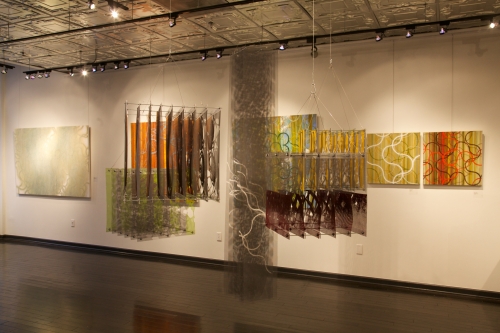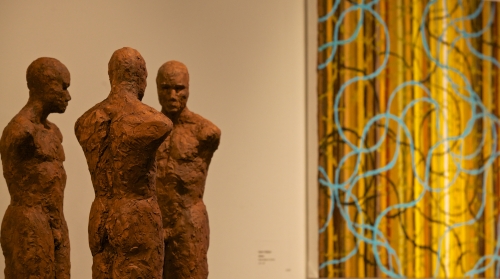Cynthia Fountain, Director of Artetude Gallery in Asheville, NC addresses the topic of curation. She shares her story and some of the finer points of curating an exhibit.

Installation: “Circles and Cycles: Year 13” by Kenn Kotara
My commitment to a career in contemporary art is a consequence of a long-held passion for art combined with a defining personal journey which began with a trip to Italy in the spring of 2004. This trip awakened my desire to pursue formal training in art history, curatorial studies, and decorative art and design.
My formal background as a curator and gallery director for Artetude Gallery in Asheville, North Carolina, began with my education in fine art and curatorial training at UNC Asheville with a Bachelors degree in Art History. My Masters is in Art in Museum Studies with a concentration in curatorial studies from Georgetown University in Washington, DC.
During this time, I worked in the Office of the Curator of the Supreme Court of the United States. I served as a curatorial researcher for the Chief and Associate Justices for their private office collections. Theses are drawn from the art archives of the varied Smithsonian Institutions throughout the DC area. I also interned at Washington DC based International Arts and Artists, Inc. I worked in marketing and as an assistant exhibitions manager for multiple traveling art exhibitions to varied venues around the world.
In my spring semester at Georgetown, I earned a Certificate in Decorative Art and Design from the Sotheby’s Institute London. I continued my journey as independent curator and museum consultant before joining Artetude Gallery in the spring of 2013. Artetude Gallery is contemporary fine art gallery whose owners share an understanding of arts intrinsic power to heal. They hold a deep respect for the critical symbiosis between artist and art collector.
We showcase compelling contemporary sculpture, painting and photography from nationally and internationally recognized artists.
Artetude Gallery focuses on three objectives. We effectively represent and advance the careers of our talented artists. Secondly, we build long-term relationships that create new contemporary art collectors and exceed the needs and expectations of established collectors. And, we contribute to the physical and cultural health of our community. This commitment donates a portion of each sale of art through our Art on a Mission program to the Mission Hospital Foundation and SECU Cancer Center.
Our goal is to help our contemporary art collectors realize their personal and unique visions in building art collections of substance and meaning in both their home and office settings.

“The Conversation”, Terra Cotta, 34 x 34 x 17 by Amy Medford ; “Bateau”, Mixed Media on Canvas, 24 x 24, by Kenn Kotara
The Curatorial Process
The curatorial process at its most basic level begins by finding relationships between pieces and, by arranging them in a space so that a sense of harmony and balance may be achieved. There is not a singular approach, but a range of methods.
The process to put on an exhibition from start to finish begins with an idea, a theme, and many times in my case this is often a consultation with a single artist. With the artists in my gallery, I begin with slides or preferably a studio visit. I view the work, speak with the artist and submit a series of questions with respect to their inspiration for the body of work and its creative processes.
This not only helps determine a theme, but will provide the groundwork for my marketing efforts, exhibition guides, articles and press releases.
For many curators the creative aspect of their job is the most enjoyable; and it is for me. Once the idea and overall theme for an exhibition has been established; then a schedule is determined. This process in a museum will take years, in a gallery a minimum lead time of six months. Before you begin, you need to think through every exacting detail and leave nothing to chance. This requires a lot of preliminary research and a very strong organizational ability.
Select the artist(s) for your exhibition. Will they create new works or will they exhibit older works? Consider engaging juxtapositions between art works. Create an interesting dialogue amongst the works and the audience. Walk through the space in your mind; is there a logical flow and a sense of harmony and balance between the works? Will the audience understand what you are trying to convey?
Logistically speaking, floor plans and space considerations are essential. A curator will begin by mapping out the layout of the exhibition. You need to get to the fundamentals of your exhibition when curating an art show. What goes where? Some curators build 3D models of the gallery space and artworks, while others use software.
Many curators work hand in hand with the gallery or museum staff to create a positive and productive environment. Personally, I will organize and pre-plan all aspects working in conjunction with the artist. I attempt to make the experience as stress-free as possible by having everything planned out beforehand.
I set the opening and closing dates of the art exhibition and mark my calendar with deadlines for each facet of the project. It can be helpful to work backwards from the opening date and schedule the necessary steps needed to put on the exhibition.
The audience or clients are one of the primary concerns of the curator. Writing well is a necessary skill for an art curator. Publishing a catalog of the exhibition is one of the tasks involved when curating an art show. A catalog is great documentation and a promotional tool that can lead to future projects.
Kwanyi Pan, a Beijing-based independent curator who has curated exhibitions around the world, says, “A curator is not a creator but a facilitator for both the audience and the artists and a messenger who delivers ideas from contemporary society. A good curator needs to understand the audience and to fully communicate with the artists to let their work speak out to the public.” I would agree with Pan in that the artist creates and I as curator am the facilitator.

Wonderful profile on Cynthia Fountain and the Artetude Gallery, which, you should visit if you are in Asheville, NC. All the best with Kenn Kotara’s show. The installation looks wonderful.
Thank you Brennen, that is very kind!
A good curator discover new emerging artist work. Unfortunately, sometimes bound by the curator of the cash inflows. Therefore, choose well-known artists who made a lot of money bringing visitors hope. I hope this does not apply to you.
Thank you Leslie, I make every attempt to do so and I am always searching for emerging artists.
Dear Cynthia. Thanks for your response, I am very happy for your open-mindedness. RECOMMENDED dr. Laszlo Csíky sculptor friend works of art. You see the product of my page mate artist menu: http://www.jegaleria.com
A very interesting article about the curation side of things. Thank you Cynthia.
Interesting to see things from a curator’s point of view. A good curator helps the artist communicate with the audience, not a matter every artist masters. Sounds like you do a great job!
Yes dear Gary, I have a really big world of work, but I also delight art lovers world-wide work. I therefore draw your attention …. promote good curator, discover always new.